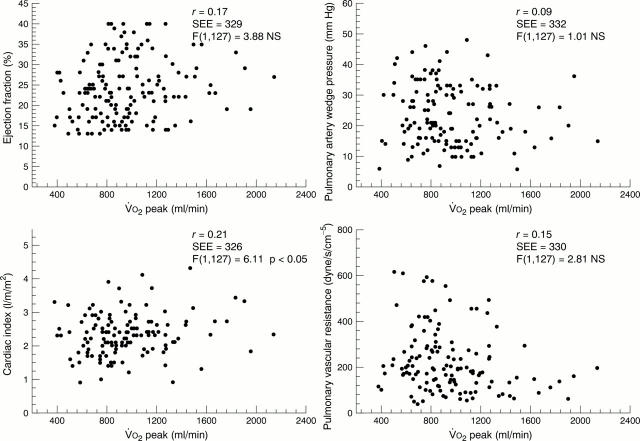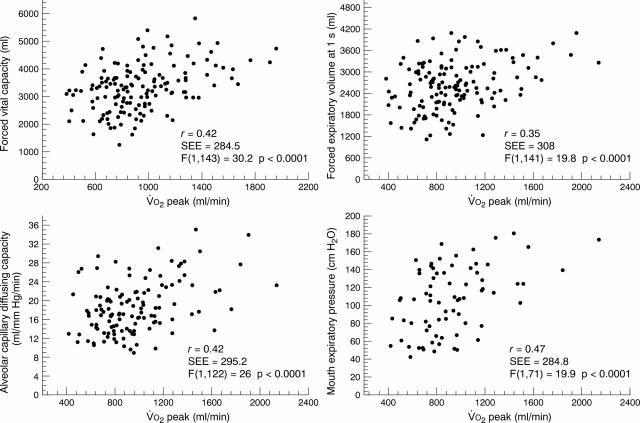Abstract
OBJECTIVE—To clarify the relative contribution of resting haemodynamic profile and pulmonary function to exercise capacity in patients with heart failure. SETTING—Cardiology department and cardiac rehabilitation unit in a tertiary centre. DESIGN—161 male patients (mean (SD) age 59 (9) years) with heart failure (New York Heart Association class II-IV, left ventricular ejection fraction 23 (7)%) underwent spirometry, alveolar capillary diffusing capacity (DLCO), and mouth inspiratory and expiratory pressures (MIP, MEP, respectively, in 100 patients). Right heart catheterisation and a symptom limited cardiopulmonary exercise test were performed in 137 patients within 3-4 days. RESULTS—Mean peak exercise oxygen consumption (V̇O2) was 13 (3.9) ml/kg/min. Among resting haemodynamic variables only cardiac index showed a significant correlation with peak V̇O2. There were no differences in haemodynamic variables between patients with peak V̇O2 ⩽ or > 14 ml/kg/min. There was a moderate correlation (p < 0.05) between several pulmonary function variables and peak V̇O2. Forced vital capacity (3.5 (0.9) v 3.2 (0.8) l, p < 0.05) and DLCO (21.6 (6.9) v 17.7 (5.5) ml/mm Hg/min, p < 0.05) were higher in patients with peak V̇O2 > 14 ml/kg/min than in those with peak V̇O2 ⩽ 14 ml/kg/min. Using a stepwise regression analysis, the respiratory and haemodynamic variables which correlated significantly with peak V̇O2 were DLCO, MEP, and cardiac index, with an overall R value of 0.63. CONCLUSIONS—The data confirm previous studies showing a poor correlation between resting indices of cardiac function and exercise capacity in heart failure. However, several pulmonary function variables were related to peak exercise V̇O2. In particular, lung diffusing capacity and respiratory muscle function seem to affect exercise tolerance during heart failure. Keywords: heart failure; exercise; pulmonary function; alveolar-capillary diffusing capacity
Full Text
The Full Text of this article is available as a PDF (206.3 KB).
Figure 1 .
Linear regression analysis between peak exercise oxygen uptake (V̇O2 peak) on the x axis and several haemodynamic variables on the y axis. See text for details.
Figure 2 .
Linear regression analysis between peak exercise oxygen uptake (V̇O2 peak) on the x axis and lung function indices on the y axis. See text for details.
Selected References
These references are in PubMed. This may not be the complete list of references from this article.
- Ambrosino N., Opasich C., Crotti P., Cobelli F., Tavazzi L., Rampulla C. Breathing pattern, ventilatory drive and respiratory muscle strength in patients with chronic heart failure. Eur Respir J. 1994 Jan;7(1):17–22. doi: 10.1183/09031936.94.07010017. [DOI] [PubMed] [Google Scholar]
- Assayag P., Benamer H., Aubry P., de Picciotto C., Brochet E., Besse S., Camus F. Alteration of the alveolar-capillary membrane diffusing capacity in chronic left heart disease. Am J Cardiol. 1998 Aug 15;82(4):459–464. doi: 10.1016/s0002-9149(98)00360-9. [DOI] [PubMed] [Google Scholar]
- Cabanes L., Costes F., Weber S., Regnard J., Benvenuti C., Castaigne A., Guerin F., Lockhart A. Improvement in exercise performance by inhalation of methoxamine in patients with impaired left ventricular function. N Engl J Med. 1992 Jun 18;326(25):1661–1665. doi: 10.1056/NEJM199206183262503. [DOI] [PubMed] [Google Scholar]
- Clark A. L., Poole-Wilson P. A., Coats A. J. Exercise limitation in chronic heart failure: central role of the periphery. J Am Coll Cardiol. 1996 Nov 1;28(5):1092–1102. doi: 10.1016/S0735-1097(96)00323-3. [DOI] [PubMed] [Google Scholar]
- Dimopoulou I., Tsintzas O. K., Daganou M., Cokkinos D. V., Tzelepis G. E. Contribution of lung function to exercise capacity in patients with chronic heart failure. Respiration. 1999;66(2):144–149. doi: 10.1159/000029356. [DOI] [PubMed] [Google Scholar]
- Drexler H., Riede U., Münzel T., König H., Funke E., Just H. Alterations of skeletal muscle in chronic heart failure. Circulation. 1992 May;85(5):1751–1759. doi: 10.1161/01.cir.85.5.1751. [DOI] [PubMed] [Google Scholar]
- Faggiano P. Abnormalities of pulmonary function in congestive heart failure. Int J Cardiol. 1994 Mar 15;44(1):1–8. doi: 10.1016/0167-5273(94)90060-4. [DOI] [PubMed] [Google Scholar]
- Faggiano P., D'Aloia A., Gualeni A., Ambrosino N., Pagani M., Giordano A. Dobutamine-induced changes in pulmonary artery pressure in patients with congestive heart failure and their relation to abnormalities of lung diffusing capacity. Am J Cardiol. 1998 Nov 15;82(10):1296-8, A10. doi: 10.1016/s0002-9149(98)00622-5. [DOI] [PubMed] [Google Scholar]
- Faggiano P., D'Aloia A., Gualeni A., Giordano A. Hemodynamic profile of submaximal constant workload exercise in patients with heart failure secondary to ischemic or idiopathic dilated cardiomyopathy. Am J Cardiol. 1998 Feb 15;81(4):437–442. doi: 10.1016/s0002-9149(97)00949-1. [DOI] [PubMed] [Google Scholar]
- Franciosa J. A., Baker B. J., Seth L. Pulmonary versus systemic hemodynamics in determining exercise capacity of patients with chronic left ventricular failure. Am Heart J. 1985 Oct;110(4):807–813. doi: 10.1016/0002-8703(85)90461-2. [DOI] [PubMed] [Google Scholar]
- Franciosa J. A., Park M., Levine T. B. Lack of correlation between exercise capacity and indexes of resting left ventricular performance in heart failure. Am J Cardiol. 1981 Jan;47(1):33–39. doi: 10.1016/0002-9149(81)90286-1. [DOI] [PubMed] [Google Scholar]
- Francis G. S., Goldsmith S. R., Cohn J. N. Relationship of exercise capacity to resting left ventricular performance and basal plasma norepinephrine levels in patients with congestive heart failure. Am Heart J. 1982 Oct;104(4 Pt 1):725–731. doi: 10.1016/0002-8703(82)90003-5. [DOI] [PubMed] [Google Scholar]
- Guazzi M., Agostoni P. Angiotensin-converting enzyme inhibition restores the diffusing capacity for carbon monoxide in patients with chronic heart failure by improving the molecular diffusion across the alveolar capillary membrane. Clin Sci (Lond) 1999 Jan;96(1):17–22. [PubMed] [Google Scholar]
- Guazzi M., Agostoni P., Matturri M., Pontone G., Guazzi M. D. Pulmonary function, cardiac function, and exercise capacity in a follow-up of patients with congestive heart failure treated with carvedilol. Am Heart J. 1999 Sep;138(3 Pt 1):460–467. doi: 10.1016/s0002-8703(99)70148-1. [DOI] [PubMed] [Google Scholar]
- Guazzi M., Marenzi G., Alimento M., Contini M., Agostoni P. Improvement of alveolar-capillary membrane diffusing capacity with enalapril in chronic heart failure and counteracting effect of aspirin. Circulation. 1997 Apr 1;95(7):1930–1936. doi: 10.1161/01.cir.95.7.1930. [DOI] [PubMed] [Google Scholar]
- Kindman L. A., Vagelos R. H., Willson K., Prikazky L., Fowler M. Abnormalities of pulmonary function in patients with congestive heart failure, and reversal with ipratropium bromide. Am J Cardiol. 1994 Feb 1;73(4):258–262. doi: 10.1016/0002-9149(94)90230-5. [DOI] [PubMed] [Google Scholar]
- Kraemer M. D., Kubo S. H., Rector T. S., Brunsvold N., Bank A. J. Pulmonary and peripheral vascular factors are important determinants of peak exercise oxygen uptake in patients with heart failure. J Am Coll Cardiol. 1993 Mar 1;21(3):641–648. doi: 10.1016/0735-1097(93)90096-j. [DOI] [PubMed] [Google Scholar]
- Lapu-Bula R., Robert A., De Kock M., D'Hondt A. M., Detry J. M., Melin J. A., Vanoverschelde J. L. Relation of exercise capacity to left ventricular systolic function and diastolic filling in idiopathic or ischemic dilated cardiomyopathy. Am J Cardiol. 1999 Mar 1;83(5):728–734. doi: 10.1016/s0002-9149(98)00979-5. [DOI] [PubMed] [Google Scholar]
- Mancini D. M., Henson D., La Manca J., Donchez L., Levine S. Benefit of selective respiratory muscle training on exercise capacity in patients with chronic congestive heart failure. Circulation. 1995 Jan 15;91(2):320–329. doi: 10.1161/01.cir.91.2.320. [DOI] [PubMed] [Google Scholar]
- Maskin C. S., Forman R., Sonnenblick E. H., Frishman W. H., LeJemtel T. H. Failure of dobutamine to increase exercise capacity despite hemodynamic improvement in severe chronic heart failure. Am J Cardiol. 1983 Jan 1;51(1):177–182. doi: 10.1016/s0002-9149(83)80032-0. [DOI] [PubMed] [Google Scholar]
- Meiler S. E., Ashton J. J., Moeschberger M. L., Unverferth D. V., Leier C. V. An analysis of the determinants of exercise performance in congestive heart failure. Am Heart J. 1987 May;113(5):1207–1217. doi: 10.1016/0002-8703(87)90935-5. [DOI] [PubMed] [Google Scholar]
- Moore D. P., Weston A., Hughes J. M., Oakley C. M., Cleland J. G. Bronchial hyperresponsiveness in heart failure. N Engl J Med. 1993 May 13;328(19):1424–1425. doi: 10.1056/NEJM199305133281914. [DOI] [PubMed] [Google Scholar]
- Opasich C., Ambrosino N., Felicetti G., Aquilani R., Pasini E., Bergitto D., Mazza A., Cobelli F., Tavazzi L. Heart failure-related myopathy. Clinical and pathophysiological insights. Eur Heart J. 1999 Aug;20(16):1191–1200. doi: 10.1053/euhj.1999.1523. [DOI] [PubMed] [Google Scholar]
- Puri S., Baker B. L., Dutka D. P., Oakley C. M., Hughes J. M., Cleland J. G. Reduced alveolar-capillary membrane diffusing capacity in chronic heart failure. Its pathophysiological relevance and relationship to exercise performance. Circulation. 1995 Jun 1;91(11):2769–2774. doi: 10.1161/01.cir.91.11.2769. [DOI] [PubMed] [Google Scholar]
- Puri S., Dutka D. P., Baker B. L., Hughes J. M., Cleland J. G. Acute saline infusion reduces alveolar-capillary membrane conductance and increases airflow obstruction in patients with left ventricular dysfunction. Circulation. 1999 Mar 9;99(9):1190–1196. doi: 10.1161/01.cir.99.9.1190. [DOI] [PubMed] [Google Scholar]
- Rubin S. A., Brown H. V., Swan H. J. Arterial oxygenation and arterial oxygen transport in chronic myocardial failure at rest, during exercise and after hydralazine treatment. Circulation. 1982 Jul;66(1):143–148. doi: 10.1161/01.cir.66.1.143. [DOI] [PubMed] [Google Scholar]
- Smith A. A., Cowburn P. J., Parker M. E., Denvir M., Puri S., Patel K. R., Cleland J. G. Impaired pulmonary diffusion during exercise in patients with chronic heart failure. Circulation. 1999 Sep 28;100(13):1406–1410. doi: 10.1161/01.cir.100.13.1406. [DOI] [PubMed] [Google Scholar]
- Sullivan M. J., Green H. J., Cobb F. R. Altered skeletal muscle metabolic response to exercise in chronic heart failure. Relation to skeletal muscle aerobic enzyme activity. Circulation. 1991 Oct;84(4):1597–1607. doi: 10.1161/01.cir.84.4.1597. [DOI] [PubMed] [Google Scholar]
- Uren N. G., Davies S. W., Jordan S. L., Lipkin D. P. Inhaled bronchodilators increase maximum oxygen consumption in chronic left ventricular failure. Eur Heart J. 1993 Jun;14(6):744–750. doi: 10.1093/eurheartj/14.6.744. [DOI] [PubMed] [Google Scholar]
- Webb-Peploe K. M., Henein M. Y., Coats A. J., Gibson D. G. Echo derived variables predicting exercise tolerance in patients with dilated and poorly functioning left ventricle. Heart. 1998 Dec;80(6):565–569. doi: 10.1136/hrt.80.6.565. [DOI] [PMC free article] [PubMed] [Google Scholar]
- Weber K. T., Kinasewitz G. T., Janicki J. S., Fishman A. P. Oxygen utilization and ventilation during exercise in patients with chronic cardiac failure. Circulation. 1982 Jun;65(6):1213–1223. doi: 10.1161/01.cir.65.6.1213. [DOI] [PubMed] [Google Scholar]
- West J. B., Mathieu-Costello O. Vulnerability of pulmonary capillaries in heart disease. Circulation. 1995 Aug 1;92(3):622–631. doi: 10.1161/01.cir.92.3.622. [DOI] [PubMed] [Google Scholar]
- Wilson J. R., Martin J. L., Schwartz D., Ferraro N. Exercise intolerance in patients with chronic heart failure: role of impaired nutritive flow to skeletal muscle. Circulation. 1984 Jun;69(6):1079–1087. doi: 10.1161/01.cir.69.6.1079. [DOI] [PubMed] [Google Scholar]




